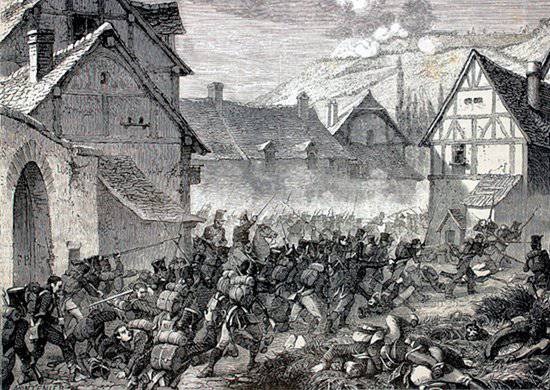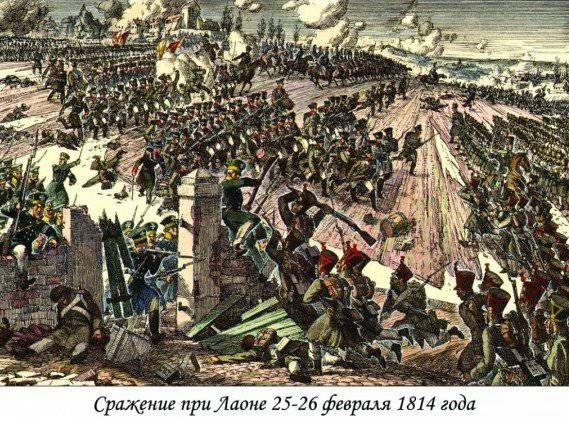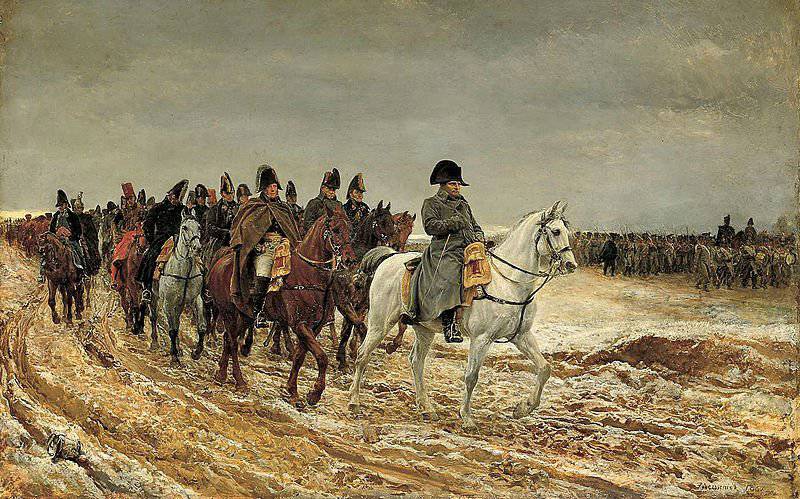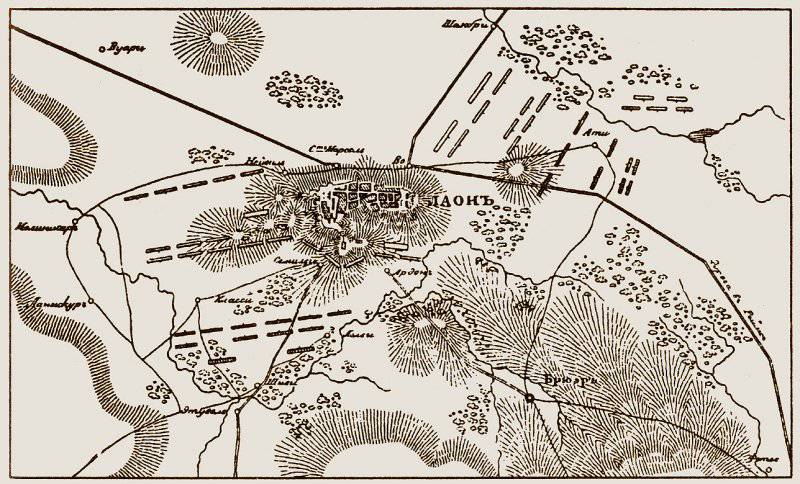Battle of Laone
Prehistory Location of troops
The Laon battle was the development of the Battle of Kraon, which took place on March 7 (The feat of the Russian troops in the battle of Kraon). French troops attacked the Russian divisions, but could not defeat them. Having received the order of command, the Russian troops in full order retreated to Laon. In the Battle of Kraon, Russian and French troops gained fame as the bravest on the continent. Both sides suffered heavy losses, but did not flinch.
On the morning of February 25 (March 9), the entire army of Blucher was located in battle formation at Laon (Lana). Blucher even took the garrison from the fortress of Soissons, which controlled the bridge over Enu. In total, Blucher concentrated about 109 thousand soldiers (67 thousand Russian, 42 thousand Prussians), of which 22 thousand cavalry, with 600 guns.
The city of Laon was located at an altitude dominating the plain. The city was surrounded by an old stone wall, had 46 towers and other fortifications. True, the walls were not in the best condition, there were several breaks. On the city shaft located a few batteries. The suburbs were located north of the fortress: Vaud, Saint-Martin, Neuville (Neuville); to the south of the village: Semilly and Ardon. The southern side of the plain surrounding the city was crossed by woods, ditches and fences, which interfered with the cavalry. In addition, the position of the army Blucher covered the river.
The Wintzingerode corps (more than 25 thousand soldiers) was located on the right wing. The infantry was built in two lines. Cavalry under the command of Count Orurka was in reserve. Artillery ahead of the infantry front. The Bülow Corps (about 17 thousand people) was located in the center. His infantry occupied the fortress, the villages of Semilly and Ardon, the suburb of Vaux and Neuville. Dense chains of shooters defended the southern and western slopes of height. The cavalry was partly occupied by roads, the other part was in reserve. Artillery was located so as to sweep the roads from Craon and Soissons, on the shaft and at the foot of the height. The corps of Kleist and York (10,6 thousand and 13,5 thousand people) constituted the left wing. Kleist's infantry stood to the right of the Reim road. In front of the outskirts of Vo is the Klux brigade, behind the Shofur manor house is the Pirch brigade. The infantry of York stood behind the Manuss Manor: in the first line was the division of Prince William of Prussia, in the second line - Horn. To the right of the road and the Shofur manor there were three battalions of Lieutenant Colonel Lettov. The cavalry of both corps is to the left and behind the infantry. Atis village was occupied by two battalions. The corps of Langeron (about 25 thousand soldiers) and Osten-Saken (12,7 thousand people) made up a general reserve. They were located between the outskirts of Neuville and Vaud.
Napoleon had 52 thousand soldiers (of which 10 thousand cavalry) and 180 guns. The French emperor decided to attack the allies in order to keep the strategic initiative in his hands. He was in a critical situation. Blucher’s army threatened Paris, and it was necessary to smash or push it back. And then it was possible to move again to Schwarzenberg. In addition, news of the failure of the talks in Chatillon did not give up hope for peace.
The French could go to Laon on the Reims or Suasson road. Reimsk road was more convenient. But for this it was necessary to return to Kraon. In this case, Napoleon could cut off the Allied army from Belgium and the Lower Rhine, but in this way the French lost communication with Paris and opened the way to the capital for the enemy. Wanting to cover Paris, Napoleon moved along the Suasson road. The corps of Marmont, who had not yet connected with the main forces, was to attack on the Rheim road.

Battle of Laon: Marshal M. Ney captures the outskirts of Semilla. 19th century engraving
Battle
9 March. In the morning, French troops, under the cover of fog, began to move toward the city. Ney was moving along the road from Shivi to Lana. Division General Boyer sent to Semilly. Marshal Mortier moved behind him, he directed the Pore division to Morvan to Ardon. Semilly was occupied by Lieutenant Colonel Clausewitz with the 1 Battalion of the East Prussian Regiment and with a part of the 4 Reserve Regiment. Prusaks blocked the streets with barricades and prepared for defense. In 9 hours, the French fired at the village, and then went to the assault. Several times the French broke into the village, but were driven back from there. Clausewitz reinforced infantry from the reserve.
At this time, the division of Pore de Morvan pushed the Prussians out of Ardon and approached the fortress. However, the Prussian counterattack threw the French into Ardon. While the advanced forces were fighting, Napoleon deployed the rest of the troops. In the first line they stood up: divisions of the corps of Ney (Boyer, Meunier and Curial) in the center, against Semilly; Mortier Corps (Division of the Young Guard of Pore de Morvan and Division of the Old Guard Christian) on the right flank of Ardon; Victor Corps, commanded by Sharpati (divisions of the Young Guard Charpentier and Boyer de Rebeval) on the left wing, against the Classy. Charpentier forces arrived a little later than the rest of the troops. The reserve was a division of the Old Guard Freean, the cavalry of Pears and Nansuti, reserve artillery. In total, at the beginning of the battle, Napoleon had about 36 thousand soldiers, including several thousand soldiers of the National Guard. Already during the battle, reinforcements were pulled up to Napoleon.
In 11 hours, when the morning fog cleared, Blucher, after examining the forces of the enemy and getting an idea of its size, ordered the attack. In addition, he received news of the appearance of an enemy column on the Rheim Road and decided to preempt the concentration of Napoleon’s army. The general offensive was preceded by a demonstrative movement of the Wintzingerode corps. The 12 Division of Prince Khovansky and the Cossacks passed through Klassi. The movement of these forces and the successful actions of the Russian artillery somewhat suspended the French. Napoleon advanced Gruvel's light cavalry to stop the troops of Wintzingerode.
Then Blucher orders the brigade Kraft to repel Ardon. The Prussians threw Roussel's cavalry and captured Ardon. A fierce battle broke out over the village. Ardon changed hands several times. The Prussians eventually captured the village. In this battle, the French divisional commander Pore de Morvan and Colonel Leclerc fell.
Blucher already wanted to throw in reserve the cavalry, which he wanted through Ardon to send to the rear of the enemy. However, they did again news on the movement of a strong enemy column on the Rheim Road. Blucher decided that these were the main forces of Napoleon, since the left flank of the Allied army was more accessible to attack the enemy. Therefore, he stopped the movement of cavalry.
Napoleon at this time had no information about Marmont. All the officers sent to him to hurry the marshal were intercepted by the Cossacks. Therefore, the emperor confined himself to attacks against Semilly and Ardon. When Charpentier's troops arrived at about 4, Napoleon ordered to strike at Klassi. The village was surrounded by swamps and was accessible only by one road. However, Napoleon sent an impressive force to this direction: two divisions of Charpentier, the division of Curial, the division of Friant. Therefore, the French quite easily drove out of the Class two battalions of the division of Prince Khovansky.
A further battle was limited to artillery and rifle shooting. After this battle subsided due to the oncoming darkness. The troops began to settle down for the night. The fighting as a whole was unsuccessful for both sides.
Laon 25-26 February Battle Plan (March 9-10) 1814
Defeat marmon's body
The corps of Marmont (about 12 Thousands of Soldiers) marched at dawn. But having met the advanced forces of the enemy, he stopped. Thick fog did not allow to determine the strength of the enemy and see the terrain. The French continued driving only at 1 one o'clock in the afternoon. The battle began with artillery fire. Then the 1 Cavalry Corps threatened the Allied left flank. General Arrigi (Duke of Padua) broke into Atis and captured him, breaking the resistance of two Prussian battalions. Marmon advanced artillery - 24 guns.
The Allied command, having received news of the movement of the French cavalry on the left flank, began to transfer additional forces to it - the reserve cavalry of the York and Kleist corps, General Benkendorf with two cavalry regiments and all Russian cavalry and artillery companies. Prussian corps moved to the left flank. Their positions were covered by the Russian corps of Langeron and Osten-Sacken.
Marmont, trying to open a message with the main forces, sent Colonel Favier with several hundred cavalry with two guns to his left flank. However, although it was only about 6 versts before Lelya, the message could not be opened. The terrain was swampy. In addition, the Don Cossacks hampered the French movement.
By nightfall, the shooting had subsided. The first day of the battle seemed complete. Marmont took the artillery from Atis. The French were planning to leave positions and return at dawn. However, they did not have time to realize their intention.
At this time, the Allied command decided to attack the enemy. The case seemed convenient to strike a superior force on a separate body of the enemy. York, Kleist and cavalry commander Ziten unanimously supported the idea of a night attack and requested the consent of Field Marshal Blucher. Prussian field marshal supported their plan. William's division was supposed to attack the village of Atis, Horn to advance to the right of this village, Kleist's corps - along the Rheims road, bypassing the enemy’s left flank. Tsiten's cavalry was to strike on the right flank and to the rear.
In complete silence, the infantry columns and squadrons of the Prussians moved in an accelerated step toward the French camp. The division of William the first to start the battle, breaking into Atis and ousting the two French battalions standing there. The French tried to gain a foothold at the wooded height behind the village, but the Prussians did not allow them to do so. The French order was broken, the gunners chopped up and seized a lot of guns. The French ran. The weak resilience of the French troops can be explained by a large number of recruits.
Horn's division was moving along a large road and, without meeting the French posts, reached an artillery position. With a lightning attack, the Prussians took the battery. Her cover was destroyed or fled. All guns captured. Kleist's troops also acted successfully. The French fled across the front.
Tsiten's cavalry knocked over several French cuirassier regiments. The French cavalry, not having had time to build, ran along the road. The Russian-Prussian cavalry overtook the artillery park of Marmont Corps. During this battle, the corps of Marmona lost almost all of his artillery fleet - 45 guns. The French have long been pursued and occupied the village of Fethiyo. The Cossacks reached Corbenn and Craon. The main forces are located at Atis.
The rout was complete. The French were able to get together only by forcing Enu at Berry-a-Bak. At dawn 10 March, the officers were able to gather only a few hundred people. Later it was possible to collect more, but the demoralized corps without artillery temporarily lost its combat capability. Case loss unknown. Only the number of prisoners is known - 2,5 thousand people. Allied forces lost several hundred people.
10 March. Napoleon's departure
The corps of York and Kleist were given the task of pursuing a defeated enemy, moving to Berry-aux-Buck, to open a message to the Main Army through Reims. Behind them the body of Osten-Sacken was also advanced. Corps Langeron had to move to Bruyere on the Kraon road and try to cut off the left flank of Napoleon's army. Corps of Wintzingerode and Bülow, when the enemy retreats, pursue him.
Napoleon, not yet knowing about the defeat of the corps of Marmon, planned to continue the offensive. The left wing was to advance from the Class and push the Allies to Neuville. Part of the force received the task of making a workaround to cut the communications of Laon. The forces stationed at Ardon should also have hit the Blucher army. When Napoleon received the news of the defeat of Marmon, he decided to continue the battle. The emperor believed that Blucher would send a significant part of his forces to Reims. This will weaken the forces of the allied army in the center and right flank, which will allow the French army to win.
On the morning of March 10, Russian troops were the first to strike. Count Vorontsov moved 12's division of Prince Khovansky to Klassi, Major-General Balk's 2's dragoon division sent to bypass enemy positions. However, General Charpentier prepared the village well for defense. All approaches were covered with rubble, artillery. Inside the village, at the height of the church, a strong battery was placed. Russian soldiers broke into the village several times, but failed to gain a foothold. Vorontsov sent several battalions of the Laptev 21 Division to help. Charpentier had to enter into battle almost all the available infantry. In addition, Nei supported the division Sharpatnya artillery. The attacks of the Russian troops were repelled. However, when Charpentier tried to launch an offensive himself, the Allied artillery caused him considerable damage and the French retreated to Clasi. Thus, the blow on the left flank of the French did not work.
In 2 hours, the Prussian reserves in the city moved back a little. Napoleon, deciding that Blücher was withdrawing the troops, ordered Her to take the city with the divisions of Curial and Meunier. However, after a fierce battle in the area of Semilly and Ardon, when the advanced units of the French approached the walls of the city, Ney's troops were forced to withdraw. Napoleon, convinced of the impossibility of taking Laon, decided to retreat. By 4 hours of the day 10 March, he began withdrawing the army from the city. Troops retreated under cover of artillery, which continued shelling of enemy positions.

Results
The allied command, although it had a triple superiority in forces, did not dare to go on the offensive. Moreover, troops aiming at pursuing Marmon received orders to concentrate at Laon. This standing could not be explained by ignorance of the enemy’s forces, they were all in full view from the top of the plateau, nor by the fear of Napoleon — the battle on the Kraon Heights and the nightly rout of Marmont showed high combat capability of the Blucher army. Apparently, this was due to Blucher’s disease. The commander on the night of 9 on 10 March was seriously ill, and the leadership of the army passed to the chief of staff Gneisenau. General Gneisenau was not very determined and did not enjoy the confidence of the troops. As a result, the army of Blucher missed the opportunity to complete the defeat of the corps of Marmont and win a decisive victory over Napoleon, giving him a quiet retreat.
Napoleon took advantage of the indecision of the Allied forces and calmly retreated. In the evening of March 10, the Old Guard departed, followed by the corps of Mortier and Ney. They were covered by one of the brigades of Nei’s corps and the uhlans of Colbert. Sharpantier's divisions and Roussel's dragoons retreated to the rearguard. 11 March, the French army retired for Enu. The French were pursued only by the detachment of Palen and the Cossack regiments of the Wintzingerode corps. In the morning of March 11, they attacked the French rearguard and captured part of the convoy and freed the prisoners captured from Laon. The other allied forces remained in place. Blucher's army remained motionless for a week.
Napoleon’s army (along with Marmon’s corps) lost 5-8 thousand people in the Battle of Laon. Allied forces lost 2-4 thousand people.
The generals were displeased with the battle. Russian generals were outraged by the indecision of command. Prussian General York was also offended that the army did not use the overnight success of his corps to inflict a decisive defeat on Napoleon. He even left the troops, causing universal amazement. Only a letter from Blucher and the brother of the King of Prussia, Prince William, forced him to return.


Information